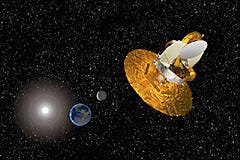A Glimpse into the Universe's Early Days
Written on
Chapter 1: The Beginning of Time
The narrative of our universe stretches back nearly 14 billion years, but we will focus on a pivotal moment in 1948. During this time, Ralph Alpher, along with Robert Herman and George Gamow, was conducting research on the Big Bang, which led to the prediction of the Cosmic Microwave Background (CMB).
The Big Bang Theory suggests that our universe was initially just a few millimeters in size 12 to 14 billion years ago. From this incredibly hot and dense state, it underwent expansion into the cooler and more expansive cosmos we know today. This theory indicates that as the gases cooled, the universe became filled with radiation known as the CMB, which is essentially the remaining heat from the Big Bang.
Fast forward to 1964, when Arno Penzias and Robert Wilson at Bell Telephone Laboratories in Murray Hill, New Jersey, were constructing a radio receiver for radio astronomy and satellite communication. They encountered an unexpected source of excess noise in the receiver. Initially attributing the interference to droppings from pigeons nesting on the antenna, they cleaned it extensively, yet the noise persisted.
At the same time, Robert Dicke and his team at Princeton University were designing an experiment to detect the CMB. After ruling out all other sources of noise, Penzias reached out to Dicke, who proposed that the interference might be the anticipated background radiation. This hypothesis turned out to be correct, and both teams published their findings in 1965. Penzias and Wilson were awarded the Nobel Prize in Physics in 1978 for their groundbreaking discovery.
The CMB remains undetectable to the human eye due to its frigid temperature of just 2.725 degrees above absolute zero (which translates to -459.67 degrees Fahrenheit or -273.15 degrees Celsius). Its radiation is predominantly observable in the microwave range of the electromagnetic spectrum. Despite being invisible, the CMB permeates the entire universe and can be detected in all directions. Since it was emitted approximately 13.7 billion years ago, a mere few hundred thousand years after the Big Bang, before the formation of stars or galaxies, detailed studies of its properties are crucial in understanding the early universe.
This leads us to the remarkable image produced from nine years of data collected by the Wilkinson Microwave Anisotropy Probe (WMAP), which was in operation from 2001 to 2010.

WMAP’s findings were instrumental in shaping the current Standard Model of Cosmology. The image illustrates temperature fluctuations—indicated by varying colors—that correspond to the primordial seeds of galaxies. This data is invaluable for cosmologists studying the formation and structure of galaxies, as well as for measuring key parameters of the Big Bang Theory.
Through our research, we have discovered that the young universe—prior to the existence of stars, planets, or galaxies—was both denser and hotter, consisting of a plasma of ionized hydrogen. The expansion of the universe caused this plasma and radiation to cool, leading protons and electrons to combine into hydrogen atoms. What was once opaque eventually became transparent, allowing photons to travel freely through space, no longer hindered by earlier interactions with electrons and other photons.
The WMAP image takes us back to just 380,000 years post-Big Bang. In 2013, the European Space Agency's Planck satellite, which succeeded WMAP, refined this image and provided the most detailed map of the cosmic microwave background to date, using data collected over 15 months. The new image revealed that the universe is not uniform in all directions, among other insights.
Take a moment to contemplate that image. It represents our universe in its infancy. We are the culmination of that expansion.
This video titled "A Picture of the Beginning of the Universe" explores the origins of the cosmos and the significance of the cosmic microwave background radiation.
Chapter 2: Unveiling Cosmic Mysteries
In "What Is the Oldest Photo of the Universe?" we delve into the history of cosmic imaging and the discoveries that have shaped our understanding of the universe.